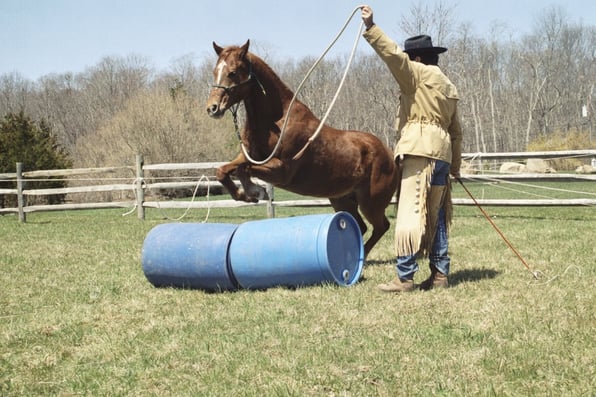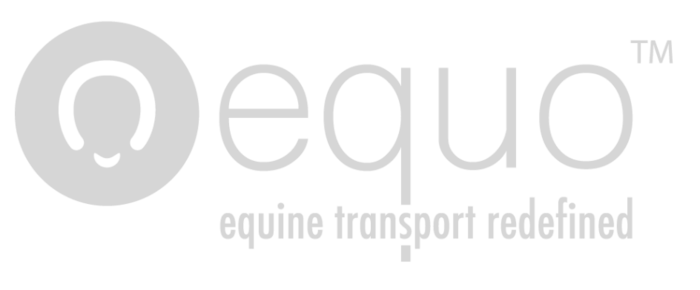The Spanish Riding School in Vienna Austria is considered by most to be the finest school of riding and horsemanship in the world. To become a member, learn classical dressage and master the art of training the great white Lipizzaners is for many the highest honor a human can achieve in the world of the horse. Whether or not one agrees with this statement is not significant. Knowing that before any student is permitted to ride they must complete four years of groundwork is, however, most definitely significant!
The purpose of all our equine teaching, starting, training, breaking, or whatever term is used, is to have the horse respond in a positive non-resistant way to all human requests.
The most sought after is riding. It can also be the most challenging. As a predator, a human sitting on the back of a prey animal horse is not only unnatural it is one of the most terrifying request we teach him to willing accept. We must teach our horses to learn how to tolerate every domestic thing we bring into their lives whether it’s horse trailers, saddles, blankets, bits, crowds, motorcycles etc.
Natural Horsemanship teaches us that before a horse can learn anything new he has three primary needs that must be satisfied: safety, comfort, and leadership.

First he must feel 100% safe. In his world this means: he’s not going to be eaten. His second need is to feel comfortable: mentally, emotionally and physically. He doesn’t want to mentally worry about why the pick-up truck with hay is driving by him without stopping. He doesn’t want to feel anxious because some of his barn buddies are walking by him and he feels left out. And he can’t be experiencing any physical discomfort like a sore back or foot, which would shift his attention from us to his pain.
Once his first two primary needs of safety and comfort are met, the horse becomes totally attentive and, in fact, eager to participate in achieving the third primary need of his species: choosing a leader.
Equine leadership is established by challenges of physical dominance. Horses would call it horseplay. Humans call it groundwork.
For either horse or human, the method of determining this hierarchy of leadership is to physically challenge another horse with dominant body language that sends a message that translates as: “I bet I can make you move your feet.” In “horseland” whomever controls the movement of another’s feet is the winner of the challenge and therefore the leader or the “better horse”. This is what makes groundwork so important. It is only when our horse trusts and respects us as his leader that he is able to learn and willingly follow our guidance and requests without resistance.
One of the most wonderful qualities of the horse, which humans also benefit from, is his innate desire to get along and fit in with others. But in order to fit in, he must first know where he stands in the “pecking” order with his herd mates…is he the leader or the follower? When we initiate groundwork that replicates the body language of equine physical dominance and, by so doing, show our horse that we can control his movement without fear, force, or pain, he naturally and willingly accepts us as his leader.
If you watch horses out in a pasture you will see this going on constantly.
A typical challenge goes something like this. Horse A finds a delicious patch of grass and starts to munch. Horse B sees this and decides he wants the same patch. He walks over gives a stern look and waits for A to move away. When A doesn’t move B pins his ears back. If A is still there, B opens his mouth, bears his teeth and swings his head toward A’s neck. Finally if A still hasn’t moved, B bites (“pecks”) A firmly on the neck. A quickly moves away from the discomfort of the bite. B gets the patch of grass and establishes his superiority over A in the pecking order.
Some horses will intermittently challenge others their whole lives. This will establish, reestablish, or change their leadership position whether it’s in a herd of 10 or a herd of 100. They may also attempt to establish, reestablish, or change their leadership in a herd of two—you and your horse!
Groundwork has many purposes. The most beneficial is to establish or reestablish yourself as the leader of your horse in your herd of two on the ground before you get on his back. Getting on his back to ride is not the time to discover that your horse still considers himself your leader. You need to establish your leadership the same way another horse would, by first controlling the movement of your horses’ feet while you are still on the ground.
One example of groundwork would be if you were connected to your horse with a halter and lead rope and you wanted him to turn and face you. You would start by giving a stern look at your horses’ hip and waiting about five seconds for him to move his hip away, which would cause his body to turn and his head to face you. If he didn’t, you would then raise your hand that is holding the lead rope in a dominant manner. If he still didn’t move you would swing your lead rope in a circle that would come within about six inches from your horses’ hip. If he still did not move his hip, you would allow the end of the swinging rope to lengthen causing your horses’ hip to be in the way of the rope and make contact with it as it went around in its circle. I guarantee that when the rope touches (bites/pecks) your horses’ hip, he will move it away and his head will face you.
This is totally different than slapping your horses’ hip with the rope. As long as you have given your horse the opportunity to move before the rope touches him, he will understand that he was the cause of being touched by the rope because he failed to get out of the way when you politely asked him the first three times. Not only will he move, he will move without becoming aggressive or resenting you. This is how we begin to earn respect from our horse.
With the natural non-verbal communication of groundwork you will have gotten your horse to respond in a positive manner, gained his respect, and begun to establish yourself as his leader. You will have done this with honesty, fairness, assertiveness, and leadership by communicating in his natural body language. To ride my horse with lightness, non-resistance, and positive responses, I need him offer all of these qualities to me on the ground before I get on his back. I won’t ask my horse to do something when I’m on his back unless he’s first done it willingly for me on the ground.
Natural Horsemanship teaches us to communicate with our horse in his language. It is only then that we can have mutual understanding that creates a true relationship with a willing partner. It is only then that we can gain the love, trust and respect necessary to allow our horse to look to us as his leader, providing us both with our two most important goals: safety and fun.
It begins with Groundwork…the key to great riding, which must always start with a great relationship.
About the Author
Tim Hayes is a Natural Horsemanship Clinician and the author RIDING HOME: The Power of Horses to Heal. Learn more at ridinghome.com. For Tim’s clinics and more go to Hayesisforhorses.com.


